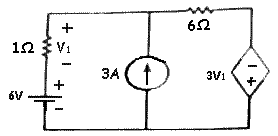Superposition Theorem Principle
In a network of resistors the current in any resistor Is equal to the algebraic sum of the currents delivered by each independent sources assuming that each source is acting alone or independently with respect to the othersNote :
If a source either a current or a voltage source) is acting alone the other current sources are open circuited while the other voltaae sources are short Circuited.
Superposition Theorem steps Demonstration :
Step 1:
If E1 is acting alone.step 2:
If E2 is acting alone.Note :
The current I1' , I2' , I3' , I1" , I2" & I3" are evaluated using basic electric circuit principleSolved problem :
Determine the current in the 6 ohm resistor using Superposition Theorem- 3.4 A
- 4.2 A
- 4.0 A
- 3.8 A
Solution :
Note about this Exemple :
whene a source is operating alone, the other current sources must be opened while the other voltage sources must be short circuited
let the voltage source to operate alone.
Apply KVL :
6+V1-I'(6) + 3V1=0
6+4V1 = 6I'1 Equation 1
V1I'=(I1= I' Equation 2
substitute E.q.2 in E.q.1:
6 +4(I') = 6I'
I' = 6/2 = 3A
I' = 3A
Let the current source to operate alone.
Apply KCL at node 'a':
3 = I1 + I"
3 = V1/1+((V1 + 3V)/6)
3 = 1.667.V1
V1 = 1.8V
I"=(4V1/6) = ((4x1.8)/6 = 1.2 A
I = I' + I" =3 + 1.2
I = = 4.2 A
Note : Since the direction of currents of both I' and I" are the same, then the resultant current that will flow in the 6 ohm resistance, is equale to the arithmetic sum of the two currents respectively.






